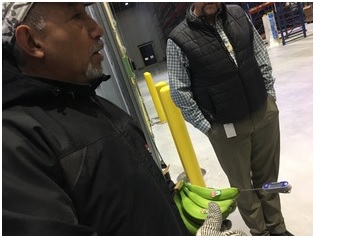

My role as a journalist recently took me to the new WinCo Foods distribution center in Denton. This is where the food you buy at nine WinCos in Texas and Oklahoma will come from.
This is WinCo’s first distribution center that combines perishable food and non-perishable items like toys and books under one roof.
We also learned that one giant room is kept at 34 degrees. Another is kept in the 40s.
Still another is kept at 12 degrees below zero. For that stop, WinCo equipped reporters with giant parkas. Our tour guides had to go fishing through a pile because the first one they handed me was a child’s medium. I tried to put it on and looked like I was doing a Chris Farley impression.
When they found another coat, though, I started to regret not taking the time to get a Seinfeld-esque photo opp while we were in there.
But here’s the story you won’t hear on the radio. Because you only get 30 seconds to talk about a story on the radio, and when you’re writing a story about a $135 million construction project, it’s possible the ripeness of the bananas involved won’t make the cut.
Or maybe the crooked media just hasn’t had the guts to do a hard-hitting story about banana ripeness.
This blog will never stop fighting for your right to get a banana that’s just the right shade of yellow. That is my pledge to you.

WinCo’s pledge to you is to provide excellent bananas.
Bananas, I learned, are the most popular fruit at most grocery stores. WinCo, and this is a real stat, says each of its stores sell about 550 boxes of bananas every week.
Each of those boxes holds 50 pounds of bananas! Who’s gonna eat all those bananas!?
This is also completely true:
WinCo has brought in their head banana guy from Oregon to train a banana apprentice (pardon the industry term, but “banantice”) for the distribution center in Denton. You’ll see in that picture, Roberto Garibay checks bananas in each box a couple times a day to make sure they’re the right temperature.
The WinCo VP would describe this course as “Banana 101.”

Listen, Scaiaholics, this reporter doesn’t much care for bananas. This reporter, at the risk of editorializing, prefers grapefruit.
But look at the care that goes into picking out the right bananas!
Garibay would explain that people are very picky about their bananas, so every week, stores send some product back. He says bananas may ripen at different paces even in the same bunch.
His job is to make sure the banana will reach maximum ripe-ness (or, and again, sorry for the industry term, “ripe-itude”) while it’s at the store. So Garibay says those hideously green bananas pictured above will sit for five or six days before they’re shipped off to stores. He focuses on the color at the ends of the bananas to determine when they’re ready.
Of course, that chart to the left is what Del Monte wants you to see.
Garibay sliced open a banana length-wise so we could take a look at how they ripen. It smelled like a cucumber!
That was normal, he said. As it gets closer, he says the banana would then go through a stretch where it smells like cantaloupe before it smells like a banana. Garibay also said bananas reach their ripe-itude at different paces, depending on where they’ve come from. To monitor that, he says he’ll adjust the temperature in the holding areas by a degree or two, depending on how the bunch is ripening.
They don’t teach you in journalism school that your career could include a course on how to harvest bananas. When I resign from society and move to Tahiti, I feel like I’m now better prepared to start a banana farm rather than breadfruit.
There’s always money in the banana stand.